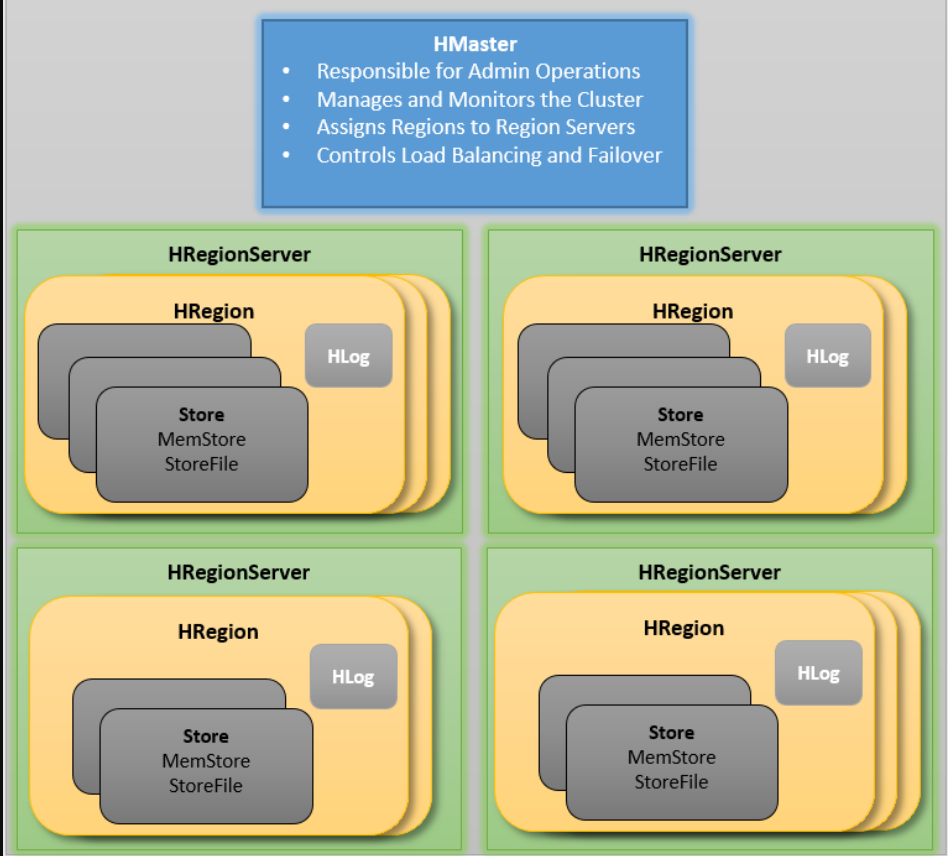HBase provides low-latency random reads and writes on top of HDFS. In HBase, tables are dynamically distributed by the system whenever they become too large to handle (Auto Sharding). The simplest and foundational unit of horizontal scalability in HBase is a Region. A continuous, sorted set of rows that are stored together is referred to as a region (subset of table data). HBase architecture has a single HBase master node (HMaster) and several slaves i.e. region servers. Each region server (slave) serves a set of regions, and a region can be served only by a single region server. Whenever a client sends a write request, HMaster receives the request and forwards it to the corresponding region server. HBase can be run in a multiple master setup, wherein there is only single active master at a time. HBase tables are partitioned into multiple regions with every region storing multiple table’s rows.
The HBase Physical Architecture consists of servers in a Master-Slave relationship as shown below. Typically, the HBase cluster has one Master node, called HMaster and multiple Region Servers called HRegionServer. Each Region Server contains multiple Regions – HRegions. Data in HBase is stored in Tables and these Tables are stored in Regions. When a Table becomes too big, the Table is partitioned into multiple Regions. These Regions are assigned to Region Servers across the cluster. Each Region Server hosts roughly the same number of Regions.

The HMaster in the HBase is responsible for
- Performing Administration
- Managing and Monitoring the Cluster
- Assigning Regions to the Region Servers
- Controlling the Load Balancing and Failover
On the other hand, the HRegionServer perform the following work
- Hosting and managing Regions
- Splitting the Regions automatically
- Handling the read/write requests
- Communicating with the Clients directly
Each Region Server contains a Write-Ahead Log (called HLog) and multiple Regions. Each Region in turn is made up of a MemStore and multiple StoreFiles (HFile). The data lives in these StoreFiles in the form of Column Families (explained below). The MemStore holds in-memory modifications to the Store (data).
The mapping of Regions to Region Server is kept in a system table called .META. When trying to read or write data from HBase, the clients read the required Region information from the .META table and directly communicate with the appropriate Region Server. Each Region is identified by the start key (inclusive) and the end key (exclusive)
Components of Apache HBase Architecture
HBase architecture has 3 important components- HMaster, Region Server and ZooKeeper.
i.) HMaster
HBase HMaster is a lightweight process that assigns regions to region servers in the Hadoop cluster for load balancing. Responsibilities of HMaster –
● Manages and Monitors the Hadoop Cluster
● Performs Administration (Interface for creating, updating and deleting tables.)Controlling the failover
● DDL operations are handled by the HMaster
● Whenever a client wants to change the schema and change any of the metadata operations, HMaster is responsible for all these operations.
ii.) Region Server
These are the worker nodes which handle read, write, update, and delete requests from clients. Region Server process, runs on every node in the hadoop cluster. Region Server runs on HDFS DataNode and consists of the following components –
● Block Cache – This is the read cache. Most frequently read data is stored in the read cache and whenever the block cache is full, recently used data is evicted.
● MemStore- This is the write cache and stores new data that is not yet written to the disk. Every column family in a region has a MemStore.
● Write Ahead Log (WAL) is a file that stores new data that is not persisted to permanent storage.
● HFile is the actual storage file that stores the rows as sorted key values on a disk.
iii.) Zookeeper
HBase uses ZooKeeper as a distributed coordination service for region assignments and to recover any region server crashes by loading them onto other region servers that are functioning. ZooKeeper is a centralized monitoring server that maintains configuration information and provides distributed synchronization. Whenever a client wants to communicate with regions, they have to approach Zookeeper first. HMaster and Region servers are registered with ZooKeeper service, client needs to access ZooKeeper quorum in order to connect with region servers and HMaster. In case of node failure within an HBase cluster, ZKquoram will trigger error messages and start repairing failed nodes. ZooKeeper service keeps track of all the region servers that are there in an HBase clustertracking information about how many region servers are there and which region servers are holding which DataNode. HMaster contacts ZooKeeper to get the details of region servers. Various services that Zookeeper provides include –
● Establishing client communication with region servers.
● Tracking server failure and network partitions.
● Maintain Configuration Information
● Provides ephemeral nodes, which represent different region servers.
- Log in to post comments